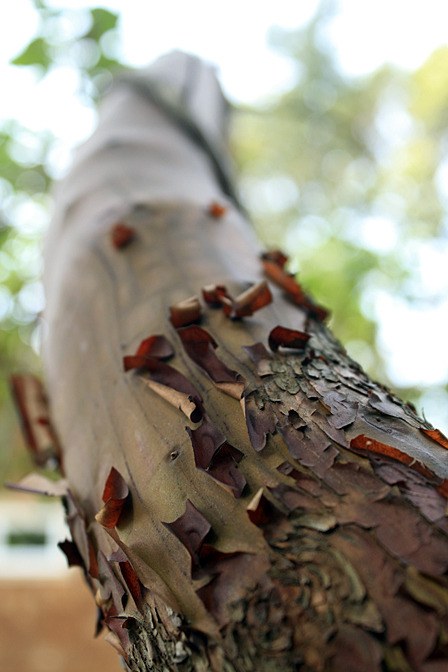Twisted and curled, their peeling bark a patina of reddish gold, madrona trees are for many here a beloved symbol of the islands’ uniqueness and stubborn independence. They thrive in rocky soil, perched along the cliffs, enduring beating rain and wind.
Entirely ornamental, their berries are inedible and their wood isn’t much use for firewood or building things. Yet we adore them, the only native broad-leafed evergreen tree.
This year, “we’ve been getting a lot of calls from all the islands,” said San Juan County WSU Extension office manager Susan Herrera. “People are concerned… This seems to be the worst year that we have had for the madronas; they look like they’re dying.”
The past few years have been tough on the graceful trees, also called Madrone or Arbutus. Many are diseased, with brown or missing leaves and ugly black cankers on their trunks and limbs. Local arborists and WSU researchers alike say they are concerned and actively studying the problem; on the other hand they don’t expect the trees to die out completely.
Marianne Elliott, plant pathologist at WSU Puyallup, sent out a request this year to the Pacific Northwest’s arboreal community, saying, “This year the Pacific madrones appear to have more severe foliar blight symptoms than usual” and asking for help mapping the blight. (Photos of foliar leaf blight are online at http://www.puyallup.wsu.edu/ppo/madrone/diseases/foliar_blight_2011.htm.)
Local arborists are more concerned about cankers.
“We have seen 18 or so leaf diseases and two major cankering diseases over the past few years, and it’s been getting worse,” said Orcas arborist Herlwyn Lutz.
Lopez Island arborist Fred Ellis said canker-causing natrassia and fusicoccum fungi stop up the capillaries in the cambium so that fungicides cannot penetrate and protect the trees.
“It’s a choking disease,” he said.
Orcas arborist John Olson said he’s observed rampant blight due to several fungi in the past few years but has not seen whole areas die out, as with sudden oak death.
“These diseases have cycles,” he said. “They’ll be present for a time and then they’ll recede… but it’s a big concern to arborists and botanists that the diseases are spreading.”
San Juan island master gardener Jim Cooper, in a paper called “What’s Wrong with my Madrone?”, wrote that the most lethal disease may be phytophthora cactorum, a fungus that causes root and collar rots to girdle and kill the trees.
Elliot is currently researching whether climate change and management practices like fire suppression may be a factor for the diseases.
Lutz said treatment of diseased trees is expensive and won’t necessarily work; phosphoric acid can forestall the cankering, but only if applied in time.
Beyond that, madronas are best off left well alone. The arborists advised taking care not to damage the trees or their roots, and said not to water, fertilize or chemically spray them.
“Like other native trees, [they] need well drained soil,” Lutz said. “People have killed them by trying to landscape or plant lawns around them.”
Lutz added that much of the browning observed by residents of late is actually due not to disease, but to an early freeze last November, advising residents to wait until new growth emerges, before removing limbs or trees as “dead.”
Although the trees are finicky once grown, some say they are easy to grow from seed on location.
To help map the location of the blight, contact Elliott at melliott2@wsu.edu or visit http://goo.gl/gVTKN.




